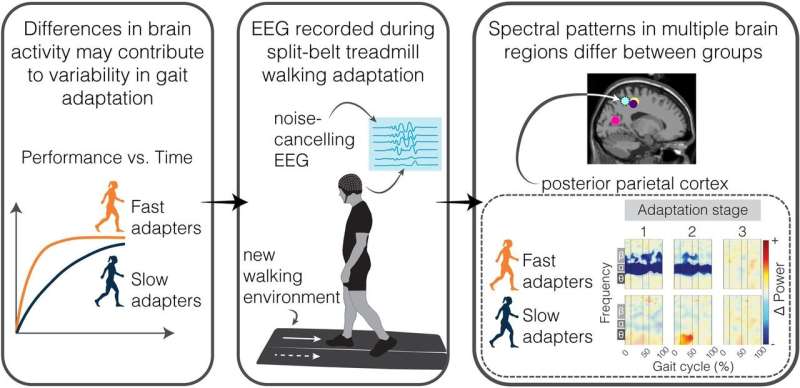This article has been reviewed according to Science X's editorial process and policies. Editors have highlighted the following attributes while ensuring the content's credibility:
fact-checked
peer-reviewed publication
trusted source
proofread
How our brains learn new athletic skills fast: Investigating electrocortical activity and faster locomotor adaptation

You join a swing dance class, and at first you're all left feet. But—slowly, eyes glued to the teacher—you pick up a step or two and start to feel the rhythm of the big band beat. A good start. Then you look over and realize the couple next to you has picked up twice the steps in half the time. Why?
According to a new study from University of Florida biomechanical researchers, the quick, athletic learners among us really are built differently—inside their brains.
That's what UF Professor of Biomedical Engineering Daniel Ferris, Ph.D., and his former doctoral student, Noelle Jacobsen, Ph.D., discovered when they studied how people learn new motor skills. They hooked up dozens of healthy people to brain-monitoring electrodes and had them walk on a treadmill with two belts moving at different speeds. The treadmill forced people to rapidly learn a new way to walk.
"Noelle was able to analyze brain activity of the best learners versus the slow learners and, lo and behold, some of the areas that were important were very clear in their brains," Ferris said.
"The biggest surprise to us was that the visual cortex was very involved in the differences between the slow and fast learners. That suggests there's something about visual information that is key to how you're learning to move your body."

This isn't the first evidence for the role of visual information in acquiring new skills. Ferris' lab has also shown that briefly interrupting vision can speed up learning how to walk on a balance beam.
In addition to hinting at how some of us pick up dance moves more quickly, the importance of visual processing could add to understanding the well-known link between vision problems and fall risks among older adults. In addition to making it harder to spot trip hazards, "if you're having trouble with vision, you may have problems learning new motor skills," Ferris said.
Quick learners took about a minute to adjust and develop a comfortable walking cadence on the treadmill; the slower group took four times as long on average. In addition to using the visual processing areas of their brains, fast learners also showed high activity in the regions involved in processing and planning muscle movements, as the scientists predicted. An error-correction region of their brains, known as the anterior cingulate cortex, was also activated to respond to the unusual gait.
Ferris and Jacobsen, who is now a postdoctoral researcher at Imperial College London, published their findings June 13 in the journal eNeuro.
More information: Noelle A. Jacobsen et al, Exploring Electrocortical Signatures of Gait Adaptation: Differential Neural Dynamics in Slow and Fast Gait Adapters, eNeuro (2024). DOI: 10.1523/ENEURO.0515-23.2024




















